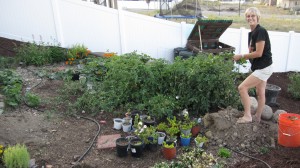How to plant a plant – part three – Sandy Soils
Posted on October 12, 2009 by sonjabarrie
Sandy soils, sounds easy, dig in fork, turn over dirt put in plant. The trouble with sandy soils is though, when you try to lift a fork full of sandy soil it ll falls between the times, there’s nothing to hold it all together. It also means there’s nothing to hold the moisture either.
Sandy soils are actually very nice towork with and you can easily make them the perfect growing mediu,m with a few additions. Firstly you to add something that will not only hold the moisture but nutrients as well. Because sandy soil drains so easily you need to water more, there’s nothing there to keep the pant moist especially if you live in a hot climate. This also means that any fertilizer or other nutrients you put into the soil are easily leached out everytime you water so your plant starves and swings between wet and dry instead of a constant slightly moist
So what is one to do. You can start by adding a woody mixture, composted bark is brilliant, once dampened it stays that way unless subjected to direct sunlight. Make sure it is well composted though or you will be draining nitrogen out of your already depleted soil, bark and most other organic material require nitrogen and phosophorus to break down and compost.. Putting it in a compost bin for a year will certainly sort out that problem.
It is very easy to get cheap "fine wood chippings" here where I live in Utah but they are straight from the chipper and need to be composted. Layering it in my compost bin with any weeds I pull up, grass clippings, pruned material etc and it breaks down wonderfully. Layering is good as too much woody stuff and it’s hard to get it damp enough or to start the composting process, too much soft stuff like grass clippings and it just sits there and becomes slimy so you need the mix.
It is so easy to build a compost bin, the pictue below shows me in the vegetable patch with the one Tim made for me from spare pallets behind me. I stained the pallets and we used some plastic roofing type material to cover the bin, that way it doesn’t get too wet or too dry and the neighbors don’t complain about the look! The one he made for me in England had a green tarp cut to shape to cover the bin, the trick is to use what you have without spending loads of money. Yeah I know I’m a tight arse, tell me something I don’t know!
Me with the compost bin in the background
You also need to keep in mind that the smaller the pieces you put in the compost bin the faster they will compost, having a shredder is a dream, I had one in England but so far I have had to laboriously cut up everything by hand since we have been in the states, still it keeps me off the streets ;o)
As most plants like well drained or at least slightly moist soil, sandy soil (if conditioned properly) is a dream. Regular soil, (loam) not too clay, not too sandy is brilliant too as you can add sand if you need it for those plants that like it that way or add acid for acid loving plants like rhododendrons etc. All you need to do is find out what soil you have and go from there.
One easy way is on an ordinary day, not too hot and not after rain or watering etc dig up a shovel full, at least a shovel depth deep and run the soil through your fingers, does it clump together and is thick, slimy smelly, very fine grained, and probably gray (or any combination of these)? Then you have clay, welcome to my world. If the soil is fairly fine, crumbly, doesn’t hold together when squished into a ball even when wet, you have sandy soil. If however it is black to brown, holds together when squished but is not heavy, crumbles when rubbed between your fingers and has that wonderful earthy smell then you are very lucky. You have loam.
Having loam is great, apart from adding the ocasional top dressing of bone meal, compost or other natural fertilizer you will have to do very little to grow anything (except acid plants of course but some loams are acid but that’s another post) even with the best type of soil it can become "tired", plants will take out all the nutrients over time. One reason forest floors are so high in nutrients is because the leaves fall, compost and put nitrogen and other needed nutrients back into the soil, we on the other hand like to "tidy up" our beds so we take away all those stems and leaves that could compost in situ, that’s great as long as you put them in a compost bin so that you can add them all back again!
One Response to “How to plant a plant – part three – Sandy Soils”
Leave a Reply










 Facebook
Facebook
FoxFarm
- 23rd Jan, 23 01:01pm
Sandy soils are actually very nice towork with and you can easily make them the perfect growing mediu,m with a few additions. Firstly you to add something that will not only hold the moisture but nutrients as well. Because sandy soil drains so easily you need to water more, there’s nothing there to keep the pant moist especially if you live in a hot climate. This also means that any fertilizer or other nutrients you put into the soil are easily leached out everytime you water so your plant starves and swings between wet and dry instead of a constant slightly moist <a href="https://www.thehydroponiccity.com/products/ocean-forest-potting-soil-mix-38-5-quart-1-5-cu-ft">Fox Farm</a>
Thanks